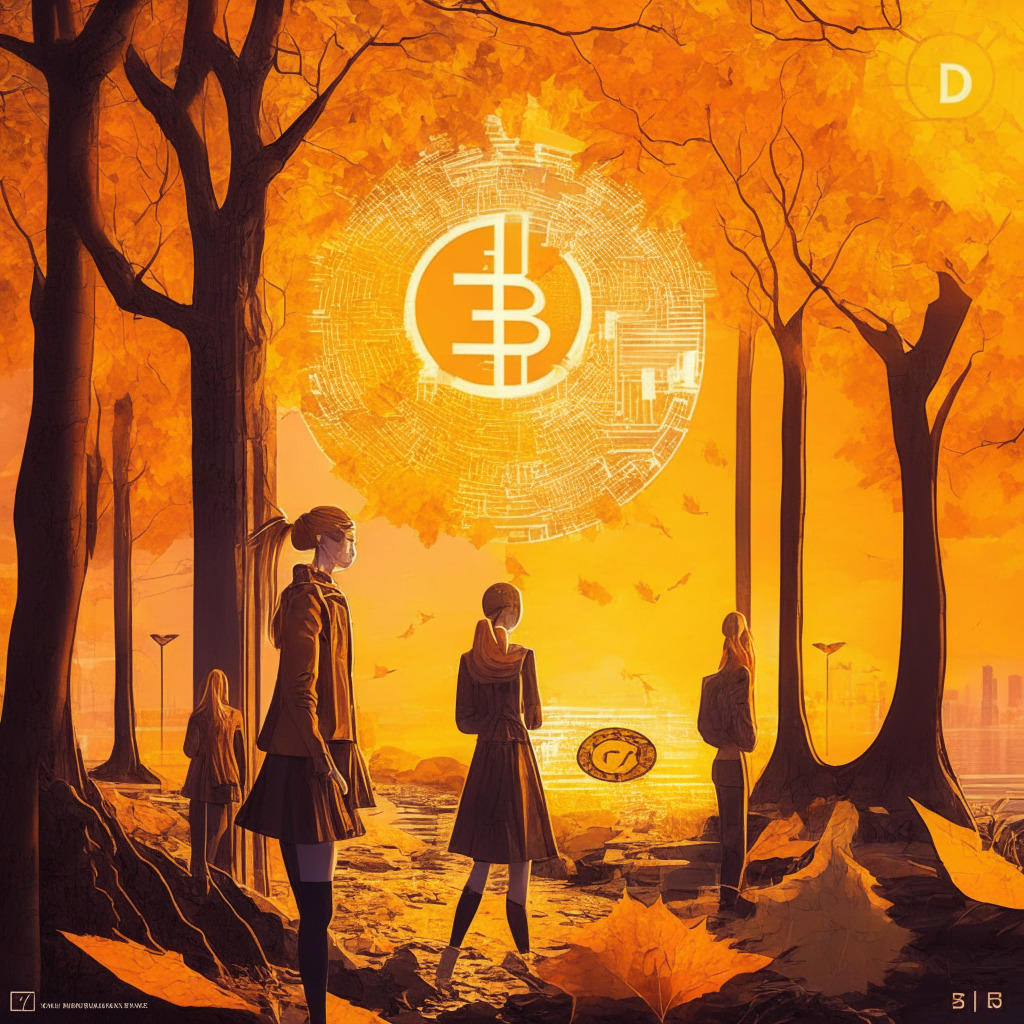“The newly launched Banana Gun’s token, BANANA, fell by over 99% within three hours due to a bug in the token’s contract. Despite identifying the flaw, the incident raised concerns about the reliability of AI-powered systems for auditing and writing code, prompting a reevaluation of conventional auditing processes. Meanwhile, the rise of bot-enabled trading systems highlights an undercurrent of risk despite their convenience.”
Search Results for: treasury
Arbitrum’s Fall: Unraveling the Possible Causes Behind its 14.5% Price Drop
Arbitrum, a leading layer-2 Ethereum solution, faces a downturn marked by a 14.5% token price plunge, decreased decentralized application activity, and a dip in total value locked (TVL) to $1.6 billion. This suggests potential investor uncertainty amidst growing competition and declining network usage, casting doubt on ARB’s future unless it successfully boosts transaction volumes and expands its user base.
Riding the Crypto Storm: The Tale of Maple Finance, DeFi and Risk Management
Late in 2021, Maple Finance introduced a digital lending protocol promising token-skeptical institutions a share of Alameda Research’s trading profits. However, the crypto downfall in 2022 caused a significant impact on Maple, highlighting the inherent vulnerability of the DeFi space and the need for stringent risk management practices.
North Korean Lazarus Group’s $41M Crypto Casino Heist: A Detailed Examination
The FBI has identified North Korean hacking group, the Lazarus Group, as responsible for the theft of $41 million from online crypto casino Stake. The large-scale cyber theft affected multiple blockchain networks including Ethereum, BNB Chain, Bitcoin, and Polygon.
Fed’s Potential $100B Loss and Its Impact: Turmoil or Triumph for Bitcoin?
Industry analyst Marcel Pechman discusses the challenges inflation presents to the Federal Reserve and the potential financial risks of their lenient monetary strategy. He suggests these issues may lead individuals to explore secure alternatives like Bitcoin and other blockchain technologies.
Hong Kong’s Digital Yuan Testing Phase II: A Leap to Future or a Threat to Privacy?
“Hong Kong is advancing on the second phase of technical testing for China’s digital yuan, focusing on the digital wallet’s top-up functionality via the Faster Payment System. Concomitantly, the city grapples with challenges balancing financial innovation and consumer protection in the fast-paced digital currency landscape.”
Impending Shift in Crypto Asset Reporting: A Boon for MicroStrategy and Future of Digital Assets
MicroStrategy is expected to report its bitcoin holdings without disclosing impairment losses, thanks to a new amendment by the Financial Accounting Standards Board (FASB). This could potentially erase MicroStrategy’s cumulative impairment losses of $2.23 billion since the start of its bitcoin strategy in 2020.
Digital Yuan and ASEAN: Exploring Opportunities, Challenges and the Undeniable Impact on Global Trade
China is looking to showcase the capabilities of its Central Bank Digital Currency, the digital yuan, to ASEAN nations, potentially indicating a cross-regional usage. Political diversity among ASEAN members and their affiliations could, however, influence this dynamic. Amid de-dollarization efforts in the region, Beijing’s digital yuan could find an increasing role. Opportunities may also arise from Bank of Indonesia’s interest in cross-border CBDC usage.
Accounting Transformation: A Boost or Bust for Crypto Adoption in Businesses?
The Financial Accounting Standards Board (FASB) plans to adopt fair-value accounting for cryptocurrencies, allowing businesses to immediately reflect gains and losses in their income statements. This could encourage more businesses to accept digital currencies as assets. However, concerns about their volatility continue to pose hesitations.
Shifting Winds: Gen Z and Millennials Fuel Crypto Revolution Despite Traditional Investment Fears
“Recent data shows crypto surpassing stocks among young investors, marking a shift in wealth with about $70 trillion projected to transition to future generations. Financial advisors are crucial in navigating this unfamiliar terrain, starting with education about the fundamental premise of blockchain technology, which underpins crypto assets.”
Navigating Polkadot 2.0: A Revolutionary Shift for Developer Attraction & DOT Token Economy
Polkadot’s innovative roadmap, Polkadot 2.0, aims to reimagine resource allocation to foster efficiency and inclusivity. It introduces ‘elastic cores’ for flexible computational capabilities and ensures coretime allocation aligns with developers’ evolving needs. Improved availability and budget-friendliness could potentially increase DOT tokens’ market value, while fees from coretime sales support Polkadot’s Treasury.
Google’s Blockchain Turnaround: The Dawn of NFT Gaming Advertisements and the Hidden Implications
Google has revised its advertising policy to permit promotion of blockchain-powered non-fungible token (NFT) games, affecting NFT games that abstain from promoting gambling content. However, it maintains its prohibition against game advertisements where players risk NFTs for earning additional digital assets.
Balancing Act: Ethereum’s Quest for Privacy, Regulation, and Decentralization with Privacy Pools
Ethereum’s co-founder, Vitalik Buterin, leads a privacy protocol initiative, ‘Privacy Pools,’ employing zero-knowledge proofs to verify user funds legitimacy, preserving transactional privacy. The protocol aims to create a separation that filters out funds related to criminal activities, harmoniously balancing financial privacy and regulation.
Blockchain Regulation: A Comparative Study of Nigeria’s Leaps and America’s Gains
“The article examines the progress of blockchain regulation from two contrasting perspectives: Nigeria, known for its cryptocurrency-awareness, and the US, with its comprehensive regulatory frameworks. The piece discusses the regulatory challenges in Nigeria and the US’s approach in achieving a balance between enforcement and tech evolution.”
Emerging Blockchain Regulations: A Necessary Evil for Future Prosperity?
The US Treasury and IRS are planning new regulations on digital asset brokers to achieve higher taxpayer compliance. Starting in 2025, they’ll require information about profits, losses, and gross proceeds from cryptocurrency transactions. However, this regulatory step could inadvertently limit the innovation offered by blockchain technology.
Australia’s Crypto Regulation Standoff: Balancing Market Protection and Innovation
The rejection of the Digital Assets (Market Regulation) Bill in Australia could potentially render the market vulnerable, leading to decreased consumer protection. Despite criticism, the event has triggered industry feedback and could shape future, effective crypto regulations, balancing consumer protection and innovation.
Implications of Cryptocurrency Inclusion in US Accounting Rules: The Triumphs & Tribulations
The adjustment to the FASB accounting rules extends fair value accounting to include cryptocurrency holdings, impacting all organizations that align with U.S. GAAP. This realignment redefines the understanding of discriminatory aspects like fair value, potentially encouraging more corporate adoption of crypto. However, the change also heightens the volatility risk in earnings.
Unmasking the Impact of FASB’s Proposed Accounting Rule for Cryptocurrency
The Financial Accounting Standards Board (FASB) is proposing the first U.S. specific accounting rule for cryptocurrency, endorsing a fair-value approach for measuring digital assets. This could lead to wider crypto adoption, requiring businesses to report crypto dealings in quarterly income statements, promoting increased visibility and scrutiny. However, it’s uncertain if this will accelerate or slow corporate crypto adoption.
Unraveling Blockchain: Introducing Privacy Pools for Enhanced Security and Compliance
Vitalik Buterin and his co-authors introduced novel “privacy pools” in blockchain, addressing privacy issues and crime associated with privacy mixers. These pools utilize zero-knowledge technology to separate honest transactions from unlawful activities, encouraging transparency and honesty in this digitally decentralized environment. The future of blockchain looks promising yet challenging with regard to privacy and regulatory compliance.
Rollercoaster Predictions: Bitcoin’s Potential Rise to $22K Amidst Market Uncertainty
“Despite the gloomy market sentiment and legal hurdles from SEC, market analysts forecast Bitcoin could hit the $22K mark. U.S. inflation drop and Federal Reserve’s liquidity drainage could push investors to alternative assets like Bitcoin. However, serious challenges still remain.”
Death Cross in Bitcoin’s Path: A Forecast of Decline or A Misleading Index?
The impending Bitcoin death cross, a bearish signal indicating short-term price momentum drop, could signify a market decline, strongly influenced by the strengthening U.S. dollar and perilous macro developments. Interestingly, Bitcoin’s death cross historically, hasn’t consistently yielded negative returns, poking holes in expectations of a straightforward decline.
Unmasking yPredict: A Data-Driven Trading Solution Built on Blockchain Technology
“yPredict, a trading research and analysis platform, combines AI and financial expertise, offering data-centric tools for insightful investment choices. It runs on the Polygon Matic chain using YPRED tokens, which allow access to predictive models and participation in the platform’s decision-making process. Its diverse analytical tools go beyond price predictions.”
Visa Dives into Stablecoin Payments: A Futuristic Move or an Unnecessary Intrusion?
“Visa partners with Solana blockchain, venturing into stablecoin payments. This sees Visa using stablecoins like USDC and blockchain networks such as Solana and Ethereum to increase cross-border settlement speed and offer more accessible options for fund transfers via Visa’s treasury.”
VISA Leverages Solana Blockchain and USDC Stablecoin for Faster International Payments
“VISA has enhanced its stablecoin settlement ability with Circle’s USDC stablecoin on the high-speed Solana blockchain, making it one of the first financial institutions to harness Solana for scaled settlements. VISA’s integration of stablecoins like USDC on global blockchain networks aims to improve international settlements speed and give clients a modern option to conveniently transact funds.”
The Paradox of Rate Hikes: Federal Reserve Tactics, BitMEX Perspective and the Emergence of the AI-Crypto Ecosystem
In a keynote at Korea Blockchain Week, Arthur Hayes, the founder of BitMEX, argued that Federal Reserve’s tactics to combat inflation could inadvertently fuel economic growth. He also predicted the potential of AI companies and a significant asset bubble resulting from the convergence of AI, crypto, and money printing.
London Stock Exchange Paves Runway for Blockchain Integration, Sans Cryptocurrencies
The London Stock Exchange Group is preparing to integrate blockchain technology into its trading procedures for traditional financial assets. This follows a year of research into the feasibility of combining conventional markets with blockchain’s transparent infrastructure. However, the proposed system will exclude cryptocurrencies, focusing on using blockchain to increase efficiency.
Navigating Crypto Regulations: Binance Australia’s Unfolding Narrative Amid Trials and Triumphs
“Binance Australia faces regulatory challenges and halted transactions due to high scam risks. Despite this, they remain committed to working with local authorities and resuscitating services for their customers. The Australian Treasury seeks to establish a token classification framework by 2024, marking a significant step towards a regulated crypto market.”
Australia’s Crypto Future: Binance’s Battle for Acceptance Amid Regulatory Tensions
“Cautious optimism pervades the Australian crypto community as Binance Australia General Manager Ben Rose voices confidence that regulators will create suitable guidelines for digital assets, despite recent regulatory tensions and banking blocks. Restoration of banking relationships and resuming fiat ramp service are top priorities.”
MakerDAO’s Counter-Market Surge: A Profitable Anomaly or a Dangerous Catch?
Despite the downturn in cryptocurrency prices, Maker (MKR) saw a significant rise due to modifications made to its lending rates in its core strategy. This reflects in MakerDAO’s recent bounce back to profitability, contrasted by a crypto market drop. The platform also launched a token buyback plan, boosting investor profits. Nevertheless, caution in investing practices is advised due to the unpredictable nature of the crypto space.
Tether’s New Link with Bahamas-Based Britannia Bank: A Boon or Bane for the Crypto Industry?
Tether, the issuer of popular stablecoin USDT, has established banking relations with Britannia Bank & Trust. This connection could streamline dollar transfers, improving Tether’s functioning within the traditional financial network. Britannia’s recent acquisitions and positive stance on crypto suggest this relationship is strategic for both entities, impacting the future of the crypto industry.
Binance Quietly Removes Banco de Venezuela: Blockchain Freedom Versus Economic Sanctions
Cryptocurrency exchange Binance has silently removed Banco de Venezuela from its P2P service list, mirroring U.S Treasury-imposed financial sanctions. The move raises concerns among Venezuelan crypto enthusiasts, notably because the bank plays a crucial role in Venezuela’s digital currency ecosystem. Despite the silent removal, users can reportedly circumnavigate the ban due to the P2P nature of the services.
USTY Tokens: Revolutionizing the Financial Sector Despite Intense Rivalries and Market Volatility
“USTY tokens, a tokenized version of shares in a U.S. Treasury bond ETF, are the prime example of the tokenization of real-world assets. This transition towards tokenization could create a $5 trillion market within five years. Despite challenges, tokenization has potential to transform financial infrastructure, backed by nearly sixfold increase in demand for tokenized Treasuries to $622 million this year.”































